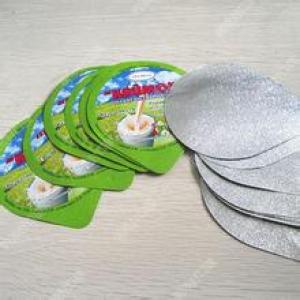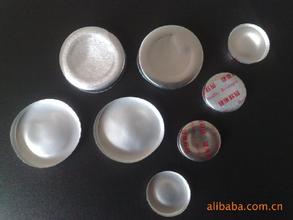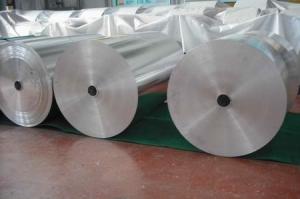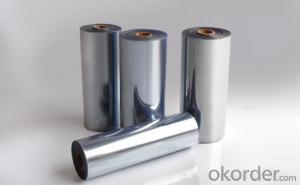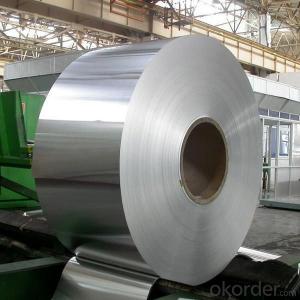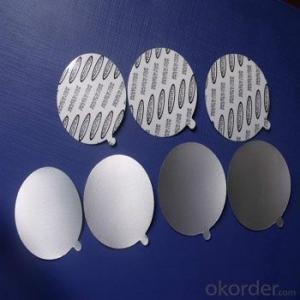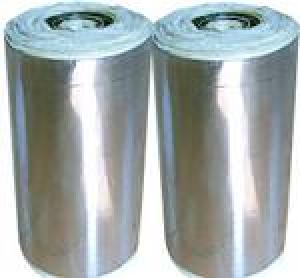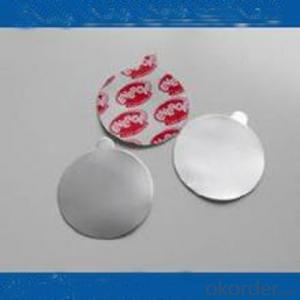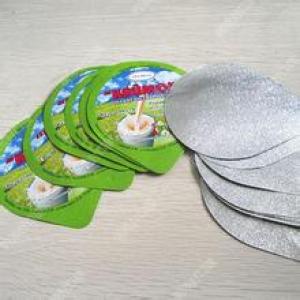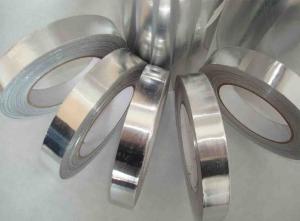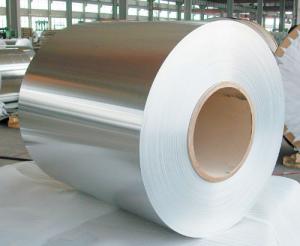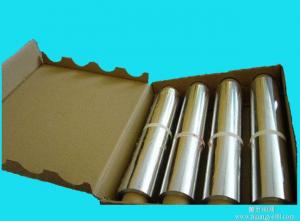Elvis Aluminum Foil Lidding Lids Foil Lid Foil
- Loading Port:
- Shanghai
- Payment Terms:
- TT OR LC
- Min Order Qty:
- 5 m.t.
- Supply Capability:
- 500 m.t./month
OKorder Service Pledge
OKorder Financial Service
You Might Also Like
Aluminium foil (or aluminum foil) is aluminium prepared in thin metal leaves with a thickness less than 0.2 millimetres (8 mils); thinner gauges down to 6 micrometres (0.24 mils) are also commonly used.In the United States, foils are commonly gauged in thousandths of an inch or mils. Standard household foil is typically 0.016 mm (0.63 mils) thick, and heavy duty household foil is typically 0.024 mm (0.94 mils). Thefoil is pliable, and can be readily bent or wrapped around objects. Thin foils are fragile and are sometimeslaminated to other materials such as plastics or paper to make them more useful. Aluminium foil supplantedtin foil in the mid 20th century.
Application: Lid of yogurt package, dairy package
Alloy: 8006/8011/8079
Temper:O
Thickness& Tolerance: 0.03mm-0.05mm(±5%)
Width& Tolerance: 200mm-1650mm(±1mm)
Mechanical Properties: Tensile Strength (U.T.S)≥50Mpa, Elongation≥1%
Standard: GB/T3198 /ASTM-B209/EN546
Annual production of aluminium foil was approximately 800,000 tonnes (880,000 tons) in Europe and 600,000 tonnes (660,000 tons) in the U.S. in 2003.
Approximately 75% of aluminium foil is used for packaging offoods, cosmetics, and chemical products, and 25% used for industrial applications (e.g. thermal insulation, cables and electronics).
In North America, aluminium foil is known as aluminum foil. It was popularized by Reynolds Metals, the leading manufacturer in North America. In the United Kingdom and United States it is, informally, widely called tin foil, for historical reasons (similar to how aluminum cans are often still called "tin cans").Metallised films are sometimes mistaken for aluminium foil, but are actually polymer films coated with a thin layer of aluminium. In Australia, aluminium foil is widely called alfoil.
- Q: Is it possible to melt metals like bronze and copper by digging a hole, placing a pipe in at an angle and attaching a blower and adding coal or charcoal to it? I have been wanting to cast scrap metals: Mostly copper, bronze/brass, aluminum, and lead that I have left over from projectsI don't have the time to build a kiln with refractory so I was wondering if this would workI could also dig in my current burn pit.Will this work?Is it safe?Will it get hot enough to melt bass and copper?Any suggestions?Thanks!
- I use two propane torches with oxygen assistYou will need a good crucibleI can and do melt bronze for lost wax sculpturesIt is dangerous as the molten bronze has no sympathy for flesh and will destroy anything that it comes in contact withPlease be careful.
- Q: I don't have a stovetop to boil water, only a roaster oven, can I just add dry lasagna noodles to lasagna and bake, will they come out? Thx!
- Guess you mean you want some stylish wheels instead of having to use hubcapsPrices vary wildly so just have to shop aroundThen you have to add the cost of having your tires remounted and balanced on the new wheels.
- Q: me and my friend had no supplies to smoke so we made our homemade bowlwe took a 1 liter bottle of coke, poke a hole through the side, took some aluminum foil poked hole in there to ventilate the smoke and then we smoked and everything seem wellbut almost instantly i felt really light headed and everything around me didnt feel right at allafter awhile like 45 min later it went away and just for the next hr or so i just had a headache.i never smoked out of aluminum or plastic before cause i know its bad for you but i had nothing else / i heard stories of people smoking from aluminum but never had these effects.so i want to know if this happend to anyone else?? or does anyone know what could've caused this feeling to occur? thnx
- Wrap it with tarps, then string another tarp or two over it like a rain fly on a tentIt'll look ugly but you can make it work.
- Q: State and explain how the first ionisation energy of aluminium will differ from that of boron.
- If the blanket is like regular material you put in the washer then it is safe with sheetsIt's all being washed right??
- Q: For example, the Harlan JSmith telescope at McDonald Observatory is a reflecting telescopeIt has a giant mirror at the base of its tube that measures 2.7 meters in diameterThe mirror is also very heavyIt weights about 4 tonsIn order to make clear images of distant stars and celestial objects, the mirror must hold its parabolic shapeTo be rigid, the mirror must be thickThe mirror is about 30 centimeters thick near the centerA shiny aluminum coating reflects incident light on the mirrorWhich side of the glass disk has the coating on it? The flat back, or the curved side facing the light? Why wouldn't it work on the other side?
- Lean meat, roasted potatoes and a green salad.
- Q: How do you determine the direction of electron flow between two metals?
- omgphysics is the hardest thing in the universei failed that with flying colors
- Q: What ion has 13 protons, 14 neutrons, and 10 electrons?
- the element is determined by how many protons it has (neutrons and electrons don't make a difference) so look on a periodic table, and you'll see that 13 is Aluminum
- Q: I ran out of smokes at the house but had pipe tobacco that a friend had sold me cheap but had no pipes or papers aroundBeing the wannabee inventor that I am, I fashioned a pipe out of a plastic Ciclon bottleWill smoking tobacco this way cause me to inhale noxious fumes? Should I insulate the area around the lid/bowl with aluminum foil to minimize the risk?
- Just get a reusable coffee cup, they look just like the paper or styrafoam onesHowever, if not get the coffee house size and have a stockpile of them
- Q: How do i make a pyramid out of air dry clay.without putting inside a kiln?
- I thought that was about 90 years agoThe French did not like it because it was being built on one of the last open areas in Paris, and it was considered uglyBut then in WW1 the French used it as a radio tower and received word that the Germans were advancing on ParisSince they were warned they held the citySo after that they appreciated itNow, it has come to represent the French, and they are actually quite proud of it.
- Q: Calculate the volume of a piece of aluminum with a mass of 25.63 and a density of 2.71 g/mLGive you answer to the correct number of significant digits and rounded correctly.
- A bbq if you have a bbq plate to go over the fire ,or a stew in the camp oven,i have cooked many things in camp ovens,even roasts biscits,and cakes as well as pudding for desert,there a good thing to have
Send your message to us
Elvis Aluminum Foil Lidding Lids Foil Lid Foil
- Loading Port:
- Shanghai
- Payment Terms:
- TT OR LC
- Min Order Qty:
- 5 m.t.
- Supply Capability:
- 500 m.t./month
OKorder Service Pledge
OKorder Financial Service
Similar products
Hot products
Hot Searches
Related keywords

